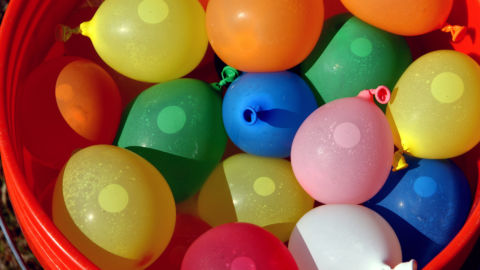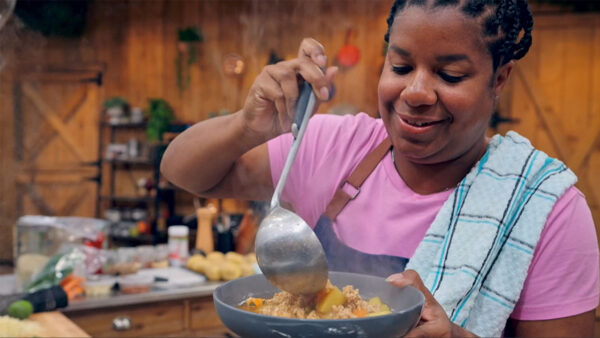By Tarana Khan, Ph.D.
This week we’re focusing on fun ways you can play with math in the summer! We’ve put together a collection of activities that will allow children to practice math skills like adding, measuring and estimating using items you probably already have around the house. We also provide a few tips on how to adapt the activities for children of different ages.
Water Balloon Math
Cool off outside with a fun water balloon math game from No Time for Flash Cards. This game allows children to practice addition through an active learning experience outdoors.
Here’s what you’ll need: Balloons filled with water, permanent marker, number targets, hula hoops and a large basket or bucket to carry and store your balloons.
Create four to five number targets by writing numbers on pieces of paper or several mini white boards. If you want to reuse your paper targets, you can put them inside page protectors or laminate them so they dry off easily. Keep in mind that all of the math equations on the water balloons will equal one of your target numbers so use smaller numbers for kids who are new to addition.
After you fill up your balloons with water, write the equations on the balloons with the permanent marker. Make sure each equation matches up with one of the target solutions. For early math learners, you could write the same numbers from the targets so that they only have to match the numbers instead of completing the equations.
Set up the targets in a clear open space in your yard or at the park. You can place the targets inside hula hoops if you have them. You might need something like a rock to weigh your targets down to keep them from blowing away.
Now it’s time to play! Pick up one of the balloons and read the equation (or the number) and find the answer on one of the targets. Toss your balloon and watch it burst as it hits the target. Keep scratch paper on hand if kids want to figure out the answer by writing or drawing the solution. Older siblings can help keep score, with higher target values being worth more points. We should probably warn you that this game could turn into a full blown water balloon fight!
And if it does, we would love to see pictures! Send your photos to [email protected].
Recommended for ages 3 to 8
Level of assistance: Help from parent, grandparent or older sibling
Make a Bottle Thermometer
Sunny days and summer heat are upon us, so it’s the perfect time to learn about temperature. Meteorologists use special tools to check the temperature outside and make predictions about the temperature in the coming days or weeks. That’s how we know whether we need to lather on extra sunscreen during the day or take a light sweater if we go somewhere in the evening. In this activity from PBS KIDS for Parents, you can build your own thermometer to measure the temperature outside. Children can learn how the temperature varies at different times of the day when they track it on their thermometer.
Here’s what you will need: an empty glass soda bottle, water, rubbing alcohol, food coloring, clear straw, modeling clay and permanent markers.
Start off by having a conversation about the weather. How does your family learn about the weather? Talk about if you hear it on the radio, on TV, or through apps on your phone. Can you tell what the weather is by looking out the window or sticking your head out the door? How does the weather help you decide what to wear?
Now build your thermometer! Pour the water and alcohol into the bottle and add a few drops of food coloring. Mix it all together by swirling the bottle around gently. Place the straw into the liquid in the bottle, but don’t push the straw all the way down to the bottom of the bottle. Secure the straw with clay at the top of the bottle. If you don’t have clay, you could also use tape.
Place the bottle thermometer in the sun and wait until you see the liquid start to rise up in the straw. Mark the outside of the bottle with a line. Help your child write the time and date of the observation. Go back to your thermometer in the evening and check the temperature again. Make a second mark on the bottle, noting the date and time. Compare the two marks. Which one is higher and why? What does the level of liquid in the straw tell you about the temperature outside?
Leave your bottle thermometer outside for a few days and mark the temperature twice a day in the morning and evening. What do you notice about how the temperature changes throughout the day? On which day did you record the highest temperature? Which day was the coldest?
The bottle thermometer represents one way to measure temperature outside. Talk about other ways you can measure the temperature inside your home using a thermostat or refrigerator thermometer inside the fridge. What about body temperature?
Recommended for ages 4-7
Level of assistance: Help from older sibling, parent, or grandparent
Weighing and Estimating with a Homemade Lego Scale
Comparing the weight of household objects and toys can be a great way to introduce the concept of nonstandard measurement, which is when you measure the weight, height, or length of objects with objects instead of traditional weighing scales or rulers. In this activity from Frugal Fun For Boys and Girls, you’ll create a Lego weighing scale out of a hanger and some string to compare the weights of objects to the weights of Legos. This is also an excellent way to practice estimating because kids can make predictions about how many Legos they think will be equal to the weight of the object in question. The more measurements you take, the more accurate estimations become.
Here’s what you’ll need: Paper to keep track of your estimations, assorted Legos of different sizes, a plastic or wire hanger, string or yarn and an assortment of objects such as toys, pencils, shoes or spice jars.
Make your estimation chart: Create three columns. Your first column will be for the name of the object, the second column will be for your guess, and the third column will be for the actual number of Legos it takes to balance the scale.
Hang the hanger on a door knob and tie two pieces of string to either side of the hanger. On one string, tie your first object, then record your guess on the chart. On the other side of the hanger, tie the Lego pieces to the string and keep adding Legos until the scale is balanced. You may need a Lego piece that has a hole that allows you to tie the string through it. If you don’t have a piece like that, you can simply tie the string around all of the Legos. Record the actual number of Lego pieces it took to balance the scale in your chart.
Ask questions along the way. After you try out your initial guess, which way is the scale tipped? Explain to your child that whichever way the scale is tipped indicates the heavier side. In order to balance the scale and make both sides weigh the same amount, you have to keep adding (or removing!) Legos. Make it extra challenging by using different sizes of Legos. For example, you might only need to add one or two small Lego pieces because the big Lego piece will make it too heavy.
Afterward, start a discussion about making nonstandard measurements and estimations. Did it become easier to guess the “Lego weight” of objects after you made several estimations? What strategies did you use to make sure the scale was balanced? Which object weighed the most and how many LEGOs did it take to balance the scale? Which object was the lightest?
Recommended for ages 5 to 7
Level of assistance: Help from older sibling or independent
This article was originally published as part of PBS SoCal’s At-Home learning initiative.
























